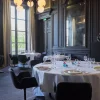In The Origin of the Work of Art, Martin Heidegger, a German philosopher and a seminal thinker, describes the essence of art in terms of the concepts of being and truth. He argues that art is not only a way of expressing the element of truth in a culture, but the means of creating it and providing a springboard from which « that which is » can be revealed.
Art can connote a sense of trained ability or mastery of a medium. Art can also simply refer to the developed and efficient use of a language to convey meaning with immediacy and or depth. Art can be defined as an act of expressing feelings, thoughts, and observations.
Art has had a great number of different functions throughout its history, making its purpose difficult to abstract or quantify to any single concept. This does not imply that the purpose of Art is « vague », but that it has had many unique, different reasons for being created. Some of these functions of Art are provided in the following outline. The different purposes of art may be grouped according to those that are non-motivated, and those that.
The non-motivated purposes of art are those that are integral to being human, transcend the individual, or do not fulfill a specific external purpose. In this sense, Art, as creativity, is something humans must do by their very nature (i.e., no other species creates art), and is therefore beyond utility. Imitation, then, is one instinct of our nature. Next, there is the instinct for ‘harmony’ and rhythm, meters being manifestly sections of rhythm. Persons, therefore, starting with this natural gift developed by degrees their special aptitudes, till their rude improvisations gave birth to Poetry. – Aristotle
Most scholars who deal with rock paintings or objects recovered from prehistoric contexts that cannot be explained in utilitarian terms and are thus categorized as decorative, ritual or symbolic, are aware of the trap posed by the term ‘art’. – Silva Tomaskova
Motivated purposes of art refer to intentional, conscious actions on the part of the artists or creator. These may be to bring about political change, to comment on an aspect of society, to convey a specific emotion or mood, to address personal psychology, to illustrate another discipline, to (with commercial arts) sell a product, or simply as a form of communication.




